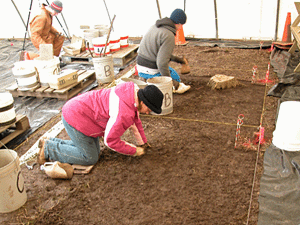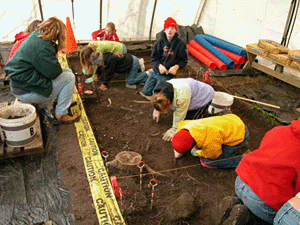The investigations of the prison hospital (Block 6) are a continuation of work began in 1990. I first explored the hospital’s latrines as part of a larger exploration of latrines from several different locations within the prison compound. This research, which focused on Blocks 1, 6, and 8, demonstrated that each localized use resulted in different materials being deposited. We unearthed the latrines first used in 1862 by Blocks 6 and 8 and the latrines used by all three blocks in July 1864. In 1995 and 1996, I further explored the earlier Block 6 latrines as well as an extension of the hospital building known as the “dead house.” Exposure of this feature revealed building materials, a few medical instruments, and one human tooth with a gold filling. The extension was constructed as an addition to the block in 1864 and would not represent the day-to-day treatment of prisoners.

Students help set up the site.
This year I’ve decided to begin investigating the main hospital building at the southern end of the block. Our first objective is to recover all the archaeological evidence contained in the plow zone above the clay subsoil. As I discovered in Block 4, the plow zone where the building stood contains much evidence of the day-to-day activities of the prisoners. Although fragmentary, the evidence speaks clearly to those actions the prisoners engaged in to pass their time. It’s my assumption that the plow zone at the location of the hospital will also represent the daily treatment of the prisoners. I expect to explore 12-16 two-meter square units within the hospital to get a representative sample of what medical treatment the prisoners were given.
My second goal is to uncover the actual location of the prison hospital. Although I am confident of the location, it is always prudent to ground truth assumptions. It is always possible that the historical accounts will not completely be born out in the archaeological record.
The same types of diseases apparent at other prisons–eruptive fevers, diarrhea, small pox, pneumonia–were some of the prevalent health issues. Another objective for this year’s work is to determine what was made available to the prisoners for treatment. We know that Hostetters Bitters was adopted by the Union for medicinal purposes. However, was this reserved for the Union guard, or was it also provided to the prisoners? Because of the unique nature of the archaeological record at the Johnson’s Island Civil War Military Prison site, the materials found within the hospital area can be assumed to be provided just for the prisoners. The Union hospital was outside the prison compound. Previous investigations have shown what was disposed within the latrines, but now we have a chance to actually recover what was provided day to day.

Fifth grade students participating in excavation
Our plan is to begin the investigations with Heidelberg College’s Experiential Learning Program in Historic Archaeology which brings middle school and high school students to the Johnson’s Island Civil War Military Prison site. This program started with the first class arriving on March 27, 2006, and there are thirty classes scheduled to participate. Each class comes the site for a day of observing the Confederate Cemetery before coming back to continue the excavation. Through this program, 24 students are brought to the site every day to participate in the recovery of historic artifacts. This program will continue until May 18. Excavations will continue through the summer until the end of July. During this time, the Heidelberg College Archaeological Field School, Teacher Workshops, and High School programs will be operating at the site. All of these programs will be geared toward the continued study of the prison hospital.
As can be seen from the map, our investigations will be focused on the southern end of the structure. Our study begins along the four units bordering the southern wall within the area noted by the red rectangle. We should begin to reveal the post holes for the southeastern corner of the hospital in the next week or two. Of course, there may be other features exposed, such as prisoner tunnels or other clandestine operations. Although there was a doctor assigned by the Union to supervise the treatment of the prisoners, often other prisoners acted as nurses or surgeons in the care of the very sick. This continual passage of healthy prisoners into the hospital would allow other secretive endeavors to take place. Perhaps our study will expose a previously unknown action.

![[image]](https://interactive.archaeology.org/johnsons/gifs/field3.gif)

Hi! Thanks a bunch for the blog. I’ve been digging around looking some info up for school, but I think I’m getting lost! Yahoo led me here – good for you I suppose! Keep up the good work. I will be coming back in a few days to see if there is any more info.